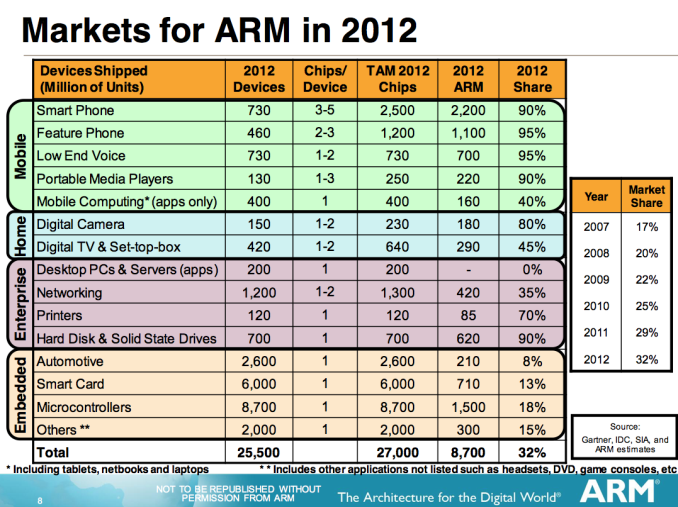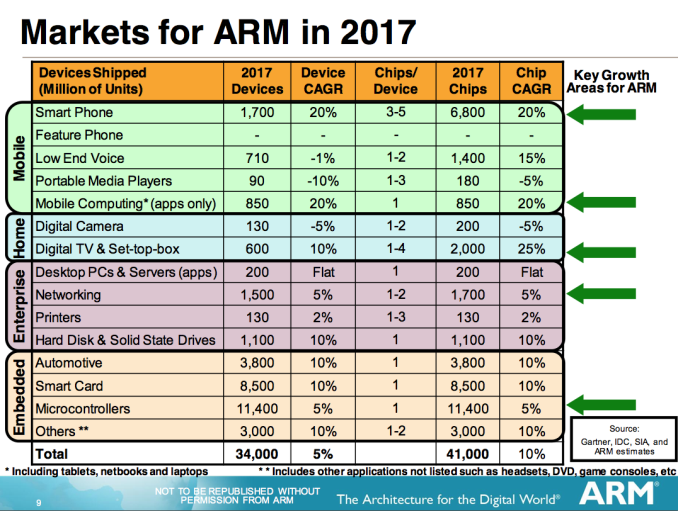The ARM Diaries, Part 1: How ARM’s Business Model Works
by Anand Lal Shimpi on June 28, 2013 12:06 AM ESTMarket Share
In 2012, ARM licensees shipped around 8.7 billion chips. Depending on the market segment, a single device can have anywhere from one to many ARM cores in it. Even looking within a smartphone you have multiple ARM cores not only within the apps processor but also inside the modem.
Although ARM has tremendous market share within the ultra mobile space (90%+), more than half of its shipments come from other segments. Enterprise, digital home, TVs, etc... are all expected to be drivers of growth for ARM in the coming years. By 2017 ARM expects its customers to be shipping roughly 41 billion chips that use ARM IP every year.
Final Words
Business models that leverage the scale and strength of a distributed production model are often very disruptive. ARM designs IP that can be implemented by fabless and fully integrated semiconductor companies very quickly, and at relatively low cost. No one member of the supply chain has to assume a significant amount of risk relative to others in the chain. It’s a far more democratic and partner centric approach to chip supply, which is one reason that it’s done so well.
ARM’s business allows for the creation and sustainability of several chip companies, which in turn keeps prices very low and prevents consolidation of power in any one firm. Although other factors (e.g. modem business, patent licensing) have lead to dominance in specific markets, ARM’s overall impact on the industry is one of promoting competition and keeping (silicon) prices low. ARM quite obviously enables what Qualcomm calls the Internet of things, where nearly everything is connected and computes.
It’s important to note that although our focus on ARM tends to be in the smartphone and tablet space, the majority of its licensed shipments come from other areas. It’s quite likely that ARM’s chances for future growth in terms of margin are in higher-end mobile SoCs, but competition from Intel in one segment surely won’t be the end of the world for ARM.
In the coming parts I’ll be taking a look at some of ARM’s newly announced microprocessor architectures such as the Cortex A12, A53 and A57. I’ll also be looking a little deeper into big.LITTLE and Mali graphics.












64 Comments
View All Comments
Crono - Friday, June 28, 2013 - link
So basically ARM is like an author who choose to work with a bunch of different publishers?It amazes me how dominant they are, though, in the mobile processor industry, all without having to manufacture chips themselves. 45 billion chips... wow. And I'm guessing there is still plenty of room to grow with more embedded chips in more devices.
airmanchairman - Friday, June 28, 2013 - link
"It amazes me how dominant they are, though, in the mobile processor industry, all without having to manufacture chips themselves. 45 billion chips... wow."Their philosophy has always been centred on the needs of their client industries, which extend far beyo
airmanchairman - Friday, June 28, 2013 - link
...nd the mobile processor industry into the vast all-purpose market (street lights, lifts, automatic turnstiles etc). These industries strictly specified the maximum power output the chips could be capable of (used to be 700mW) and ARM designed within those parameters. As such their entire R&D/Logistics/Marketing focus has been perfectly suited to the battery-power-constrained mobile industry.Intel, on the other hand, after decades of dictating to the booming desktop industry with its faster/more cores/larger plants philosophy, is only just coming to grips with the power efficiency and discipline required to compete with ARM in the rapidly growing mobile sector.
The new Haswell architecture shows the promise and potential that Intel may
airmanchairman - Friday, June 28, 2013 - link
... bring to the battle against ARM.nadim.kahwaji - Friday, June 28, 2013 - link
veryyyy nice post, anand i know that you are so busy, but we miss the podcast !!!!!!blanarahul - Friday, July 26, 2013 - link
Umm... Does Qualcomm also pay royalty for the chips that use Krait?blanarahul - Friday, July 26, 2013 - link
Is Qualcomm automatically eligible to use any of ARM designs since they are above the "Subscription Licence" level in the pyramid?dealcorn - Friday, June 28, 2013 - link
I could not follow the sense of your statement "From Intel’s perspective, it made the mistake of licensing the x86 ISA early on in its life, but quickly retreated from that business." I thought IBM required that Intel license X86 to competitors as a pre condition of IBM's selection of Intel's 8086 for the IBM PC. Did Intel made a boo boo letting IBM use the 8086 in the IBM PC? It was reported that Intel's selection of x86 license partners was driven by the dual criteria that the partner must be acceptable to IBM and also likely incompetent to exploit the benefits of the license. In retrospect, their selection of partners achieved these goals. What was Intel's licensing mistake?The aphorism, "Knitter, stick to your knitting" has long been appreciated as a useful business strategy. ARM is properly commended for it's strict adherence to this truism in it's attempted optimization of architecture design. Intel appears focused on SoC level optimization. Intel's holistic approach is more time consuming and capital intensive. Consumers will ultimately vote with their wallets which approach is better in the contested ultra mobile space.
SleepyFE - Friday, June 28, 2013 - link
Intel licensed it's IP to AMD, but AMD didn't throtle it's CPU's so it would get more business with constant iteration of the same architecture with marginal improvements to it (Intel's tic toc development model). AMD made the best use of what they got from Intel. At that time their (AMD's) CPU's were faster and they were eating away Intel's business. Intel had since then made a new architecture and did not license it to AMD. Consequently AMD fell behind and had not recovered since.Wolfpup - Friday, June 28, 2013 - link
AMD and Intel cross license x86. It's not fair to claim x86 is Intel's thing along, given how much stuff Intel has to license from AMD for it-heck, the most obvious is 64-bit. The updated ISA is AMD's design, and Intel started using it a few years later."At that time their (AMD's) CPU's were faster and they were eating away Intel's business. Intel had since then made a new architecture and did not license it to AMD. Consequently AMD fell behind and had not recovered since."
I can't remember if AMD ever actually licensed chip designs-if they did, it wasn't recent, would have been like the 486. Everything since then that AMD sells has been AMD's design. When AMD was faster, that was with entirely AMD designs. And no, Intel doesn't license Core, but that's not new like you're saying, that's been the case since the 486 days (if those were even licensed), and it's not why AMD's fallen a bit behind. Intel was making horrible decisions with their CPUs, and AMD was designing better ones. AMD's stuff is still really strong/good, it's just Intel's bigger, has thrown more resources at it, usually has a process node advantage, and since getting serious again has been able to have more powerful chips at the high end (though of course the reality is AMD's chips keep getting more powerful too, and are only "bad" in comparison to Intel's newest, and sometimes even then AMD looks better, like that platform comparison using integrated graphics where AMD's new $140 CPU was stomping on one of Intel's best i7s, often 50% better).